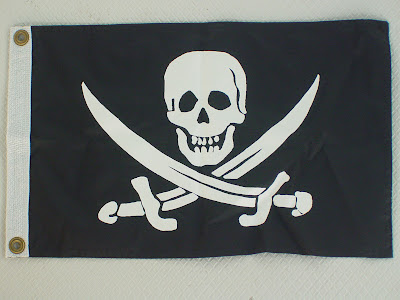Rules and regulations for the flying of flags on ships,
boats and other watercraft are an important part of seamanship. The usual rule that no flag should be flown
higher than the national flag does not apply on board a ship and a flag flown
on the stern is always in a superior position to a flags flown elsewhere.
The Ensign:
Renegade a Panamanian Flag Vessel
An ensign is a national flag when used at sea and is flown
in relation to the country of registration, so much so that the word “flag” is
often used as a synonym for “country of registration.” Ensigns are usually required to be flown when
entering and leaving harbor, when sailing through foreign waters, and when the
ship is signaled to do so by a warship.
Placement of flags on sailing vessels is dependent on the
rigging of the ship. Above is the normal
position on a sloop rigged boat;
Whilst a ketch rigged boat flies its ensign at the top of
the mizzen mast.
The “Q” Flag:
The practice of flying the yellow quarantine flag or “Q”
flag when entering a foreign harbor began in earlier times with laws enacted to
stop the spread of deadly diseases.
Today it is flown indicating that the vessel and crew have not been “cleared”
into the country by the authorities.
Regulations for customs and immigration clearance vary from country to
country. Seldom in the clearance process
am I even asked about the health of myself or the crew, so I guess the Black
Death was eradicated.
The Courtesy Flags:
Once clearance procedures are met, it is customary to remove
the “Q” flag and fly the host country’s courtesy ensign as a token of respect
by the visiting vessel. It is often a
small national maritime flag of the host country and is usually flown on the
starboard side below the lower spreader on the foremast of sailing
vessels. On a mastless
powerboat, the courtesy flag of another nation replaces any flag that is
normally flown at the bow of the boat, or can be flown from any appropriate
appendage available on the starboard side of the vessel.
Bahamas, Puerto Rico,
Turks & Cacaos & BVIs
Dominican Republic,
French Islands, St. Lucia & Antigua/Barbuda
Mexico, Canada, &
USVI
Over the years, we have collected a few flags.
Now we are flying the Grenada courtesy flag.
Maryland, Virginia,
Georgia, Florida,
and South Carolina
(missing North Carolina)
Because our hailing port is Washington, DC, we are not officially
part of the “real” 50 states. Therefore,
we usually fly the state’s flag when we are passing through. It is all part of that issue about “Taxation
Without Representation.”
Nauticat
Rendezvous
The Specialty Flags:
Seven Seas Cruising
Association
Royal
Marsh Harbour Yacht Club
Little
Farmers Cay
When we are anchored off of Little Farmers Cay, Bahamas, we fly the
“official” Little Farmers Cay flag.
Staniel
Cay Yacht Club
Diver
Down Flag
We have accumulated two of these
flags, and I like to place one on the front and one on the back of the boat
when I am doing maintenance on the bottom.
We also stick one up when we are snorkeling off of the dinghy.
Gin Pennant
A Gin Pennant means that the wardroom
is inviting officers from ships in company to drinks. The origins of the Gin
Pennant are uncertain, but it seems to have been used since the 1940s and
probably earlier. Its color, size and
position when hoisted were all significant as the aim was for the pennant to be
as inconspicuous as possible, thereby having fewer ships sight it and
subsequently accept the invitation for drinks. The Gin Pennant is still in
regular use by Commonwealth Navies, such as the Royal Australian Navy (RAN).
Within the RAN it is common practice, whilst in port, for junior officers of
one ship to attempt to raise the Gin Pennant on the halyard of another ship,
thereby forcing that ship to put on free drinks for the officers of the ship
that managed to raise the pennant. If, however the junior officers are caught
raising the pennant, then it is their ship that must put on free drinks within
their Wardroom. Usually this practice is restricted to Commonwealth Navies;
however, prior to increased force protection, RAN officers have successfully
raised the Gin Pennant on a number of units in the USN.
Source: Wikipedia, Maritime Flags
Jolly Roger
It is also appropriate to hoist the above flag up the mast
of your Pirate loving friend’s boat.
(Actually, he disapproves
of the glamorization of Pirates,
but I tricked him
into dressing up like a Pirate, and sending me the picture.)
Happy Forth of July!

.jpg)
.jpg)
.jpg)
.jpg)
.jpg)
.jpg)











.jpg)




No comments:
Post a Comment